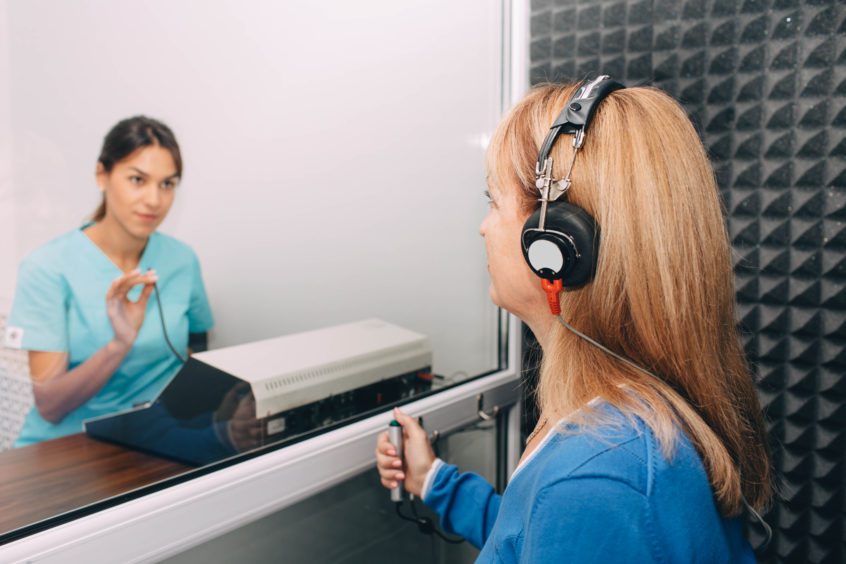You’ve noticed you’re having more and more problems hearing, but you haven’t done anything about it yet. If you’re not sure where to start, or what you need, you’re not alone. We’ll help you walk through the best way to find out if you have a hearing loss, and if you do, four features you should check for when shopping for hearing aids.
Let’s start at the beginning. Before you can decide which brand, type or features you need in a hearing aid, you need to find out if you actually have a hearing loss. Though you may see ads for free hearing tests or screenings, be cautious of those. Often, these are not a comprehensive hearing evaluation, they’re just screenings.
A screening may tell you if you have a hearing loss, but it isn’t specific. In other words, it doesn’t actually determine the type, degree or symmetry of hearing loss, or provide you with an audiogram. An audiogram is a graph of the sounds you can and can’t hear—it’s the blueprint to your hearing loss. This level of detail is necessary so that the audiologist can match your hearing loss to the best hearing device for your specific circumstances. A comprehensive hearing evaluation with history and consult should take an audiologist 60 to 90 minutes to complete. If it takes 5 minutes, you’re not getting a comprehensive evaluation.
If it’s determined that you have a hearing loss, the audiologist will review the results with you, and will discuss your hearing needs, lifestyle and budget. Today, there is a wide range of digital hearing devices available, starting at a cost of $675 per ear at a professional practice like Associated Audiologists.
More advanced hearing aids have more sophisticated features. Here are some you might want to consider:
Artificial Intelligence—Some advanced hearing aids are equipped with technology called artificial intelligence (AI) that helps target the sounds you need and want to hear, making those sounds more prominent.
This technology is able to “learn” from experience and can adjust in complex listening situations. According to the Hearing Industries Association, hearing aids built with AI can detect your environment and learn your preferences for listening via machine learning.
For example, when seated in a noisy restaurant with a friend or spouse, hearing aids with AI can automatically shift to provide more comfort or more clarity to help you hear and communicate your best. If desired, these hearing aids can remember your preferred settings and automatically adjust when you enter locations you frequently visit.
AI hearing aid features recently released include step trackers, an engagement tracker, and fall detection. Newer models of hearing aids may also connect to other smart devices so you can benefit from seamless TV and computer streaming, doorbell notifications, and smartphone notifications.
Bluetooth Hearing Aid Technology—When your hearing aids are Bluetooth-compatible, it allows you to connect with specific Bluetooth-enabled devices, such as your smartphone or iPad. In fact, Bluetooth technology has made it possible for your phone to ring and for you to hear directly through your hearing aid(s). This allows for convenient hands-free communication, as well as hearing in both ears, which results in a much clearer signal than when using a phone on one ear.
Most hearing aid manufacturers now have hearing aids that utilize Bluetooth technology compatible with Apple and some with Android phones. More sophisticated hearing aids have a streamer built in, so no additional devices, streamers or wires are necessary in order to connect from your hearing aids to other devices, like your phone. You just have to pair the devices, as long as they are compatible.
Digital Adaptive Directional Microphones—Newer digital hearing aids typically include two microphones, helping detect which direction a sound is coming from. Adaptive directional microphones are designed to prioritize speech coming from in front when other sound may interfere. This may help you hear speech better in a complex listening situation. Advanced hearing aids are actually equipped with adaptive microphones that follow the source of the sound, allowing you to keep track of conversations even as someone’s voice moves, and resulting in a more natural listening experience.
Rechargeable hearing aids—Whether you’re interested in rechargeable hearing aids because you have difficulty handling traditional hearing aid batteries, or you want a “greener” power option, most of the major hearing aid manufacturers now offer rechargeable hearing aid options.
In general, rechargeables offer technological advances beyond the battery, including improved signal processing and more automatic adjustments. These help you hear better and more comfortably in complex listening situations, like in the car, social settings, talking on the phone or watching TV. Most of this advanced technology is available in non-rechargeable options as well.
Rechargeables can be more convenient for patients who struggle with vision and/or dexterity when replacing tiny traditional hearing aid batteries. They use either integrated lithium-ion batteries or field changeable silver zinc batteries. These batteries can hold a charge for around 24 hours of use. Batteries require re-charging every night by placing them in a charging station. If you stream a lot of audio, the batteries may not last a full 24-hour day.
One downside to rechargeables is they may not be as convenient if you travel regularly or don’t have access to electricity, which is required for most recharging bases. Most technologies offer a standard disposable battery option if this is preferred or recommended.
Your initial investment when choosing rechargeable will include the charger and the cost of the first rechargeable battery or batteries. The rechargeable battery life will depend on the type of rechargeable battery your hearing aids use.
Learn more about advanced hearing aids, download our free E-book, Tech Talk.
Schedule an appointment with a doctoral-level audiologist at Associated Audiologists.



